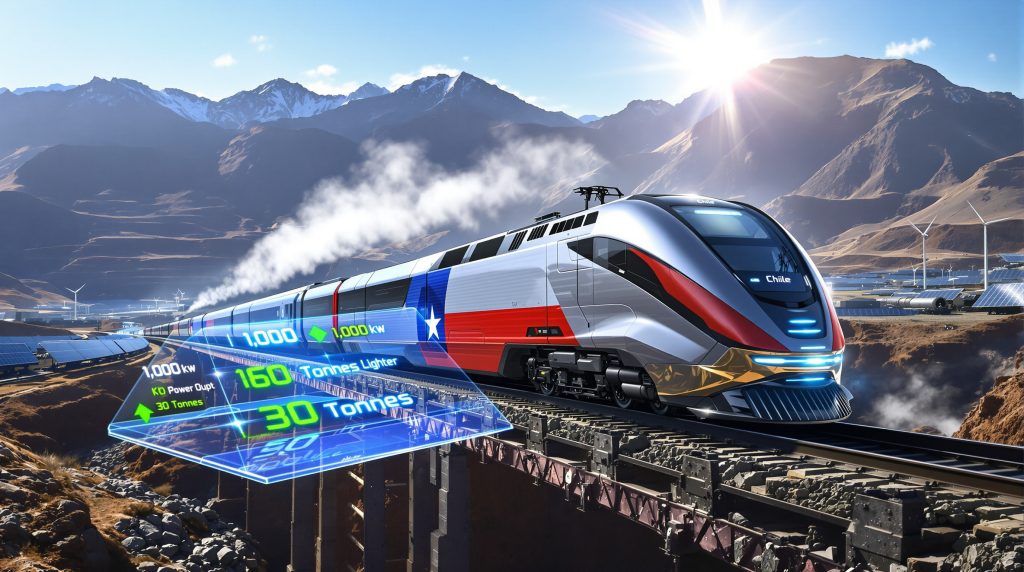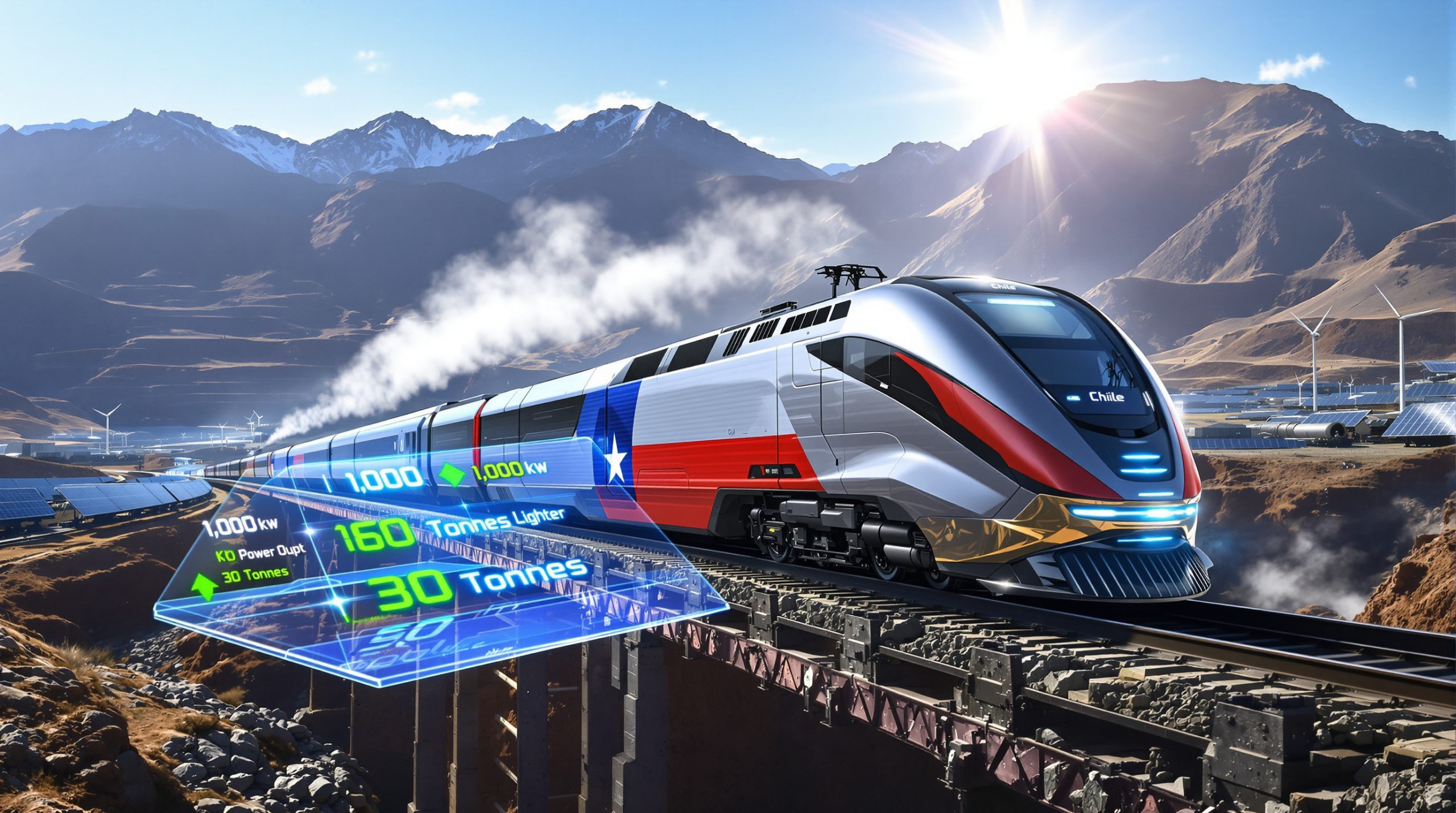Understanding Hydrogen Rail Technology in Mining-Heavy Economies
Industrial decarbonisation represents one of the most pressing challenges facing resource extraction economies today. While electric vehicles dominate passenger transport conversations, heavy freight operations require fundamentally different technological approaches. Latin America's mining regions present unique operational demands that traditional electrification struggles to meet effectively.
The emergence of the first hydrogen locomotive in Latin America demonstrates how fuel cell technology offers a compelling solution by combining high energy density with zero-emission operation. Unlike battery-electric systems that require extensive overhead infrastructure, hydrogen locomotives operate independently while maintaining the power output necessary for heavy freight operations across challenging terrain.
The technology integrates fuel cells with battery storage systems, creating hybrid powertrains capable of sustained performance over extended routes. According to Mining Weekly (November 28, 2025), these hybrid architectures combine fuel cells and batteries to deliver consistent power while eliminating carbon emissions associated with conventional diesel locomotives.
Mining companies across Latin America face mounting pressure to reduce operational emissions while maintaining productivity levels. Furthermore, the development of electrification & decarbonisation trends demonstrates how hydrogen locomotives address this challenge by offering comparable performance to diesel systems without the environmental impact. The fuel cell process converts hydrogen into electricity through electrochemical reactions, producing only water vapour as a byproduct.
Technical Specifications and Performance Metrics
FCAB's hydrogen locomotive deployment in Chile's Antofagasta region demonstrates significant technological advancement in sustainable rail transport. According to Mining Weekly (November 28, 2025), the locomotive delivers 1,000 kW of power while weighing approximately 30 tonnes less than comparable diesel models.
| Performance Metric | Hydrogen Locomotive | Diesel Comparison |
|---|---|---|
| Power Output | 1,000 kW | 1,000 kW (comparable) |
| Weight Reduction | 30 tonnes lighter | Standard weight |
| Emissions Profile | Water vapour only | Carbon dioxide, particulates |
| Fuel Source | Renewable hydrogen | Petroleum diesel |
| Maintenance Complexity | Reduced moving parts | Traditional engine maintenance |
The hybrid architecture incorporates both fuel cells and battery systems for optimal performance delivery. This dual-system approach ensures operational reliability across variable route conditions while maintaining power output consistency. However, the fuel cell component provides primary power generation, while battery storage systems supply supplementary power during peak demand periods.
Infrastructure development represents a critical component of successful hydrogen locomotive implementation. Mining Weekly (November 28, 2025) reports the construction of a dedicated hydrogen refuelling station at FCAB's Patio Norte rail yard in Antofagasta, indicating comprehensive infrastructure commitment beyond locomotive procurement.
Corporate Decarbonisation Strategies and Timeline
Antofagasta's hydrogen locomotive initiative aligns with aggressive corporate decarbonisation targets. According to Antofagasta PLC, the company aims for a 50% reduction in Scope 1 and 2 emissions by 2035 and carbon neutrality by 2050.
These targets reflect broader industry recognition that traditional operational approaches cannot meet evolving environmental standards. In addition, Scope 1 emissions include direct greenhouse gas emissions from company-owned sources, such as diesel locomotive operations. Scope 2 emissions encompass indirect emissions from purchased energy consumption.
Key Decarbonisation Milestones:
- 2025: Hydrogen locomotive pilot project initiation
- 2035: 50% reduction in Scope 1 and 2 emissions target
- 2050: Complete carbon neutrality achievement
The hydrogen locomotive in Latin America pilot serves as a technology validation mechanism for broader fleet conversion. Mining Weekly positions this initiative as part of FCAB's assessment of technical and commercial feasibility for hydrogen traction in freight operations.
Corporate sustainability commitments increasingly influence investment decisions and operational planning. For instance, mining companies recognise that early adoption of proven clean technologies provides competitive advantages in ESG-focused investment environments.
Infrastructure Investment and Operational Requirements
Successful hydrogen locomotive deployment requires comprehensive infrastructure development beyond locomotive acquisition. The FCAB project demonstrates an integrated approach combining vehicle technology with supporting systems.
Primary Infrastructure Components:
- Hydrogen production facilities utilising renewable energy sources
- Storage systems with appropriate pressure management capabilities
- Distribution networks connecting production to refuelling stations
- Specialised maintenance facilities equipped for fuel cell servicing
- Technical training programmes for maintenance personnel
Secondary Infrastructure Considerations:
- Safety protocols addressing hydrogen handling procedures
- Emergency response systems specific to hydrogen technology
- Integration mechanisms with existing rail network operations
- Supply chain development for specialised components
The Patio Norte hydrogen refuelling station represents the first operational component of this infrastructure network. According to Mining Weekly, the facility produces hydrogen from renewable sources, creating a closed-loop sustainability system that eliminates fossil fuel dependency.
Regional Geographic Advantages for Hydrogen Implementation
Latin America possesses significant natural advantages for hydrogen locomotive implementation. The region's geographic characteristics create favourable conditions for hydrogen technology adoption compared to alternative sustainable transport solutions.
Renewable Energy Resources:
- Abundant solar radiation in northern Chile's Atacama region
- Consistent wind resources along Pacific coastal areas
- Existing hydroelectric infrastructure providing baseline renewable capacity
- Government policies supporting renewable energy development
Consequently, the integration of renewable energy solutions creates optimal conditions for sustainable hydrogen production. Furthermore, hydrogen-powered mining trucks complement rail transport systems, creating comprehensive hydrogen ecosystems across mining operations.
Operational Geography Benefits:
- Long-distance freight routes maximising hydrogen efficiency advantages
- Mountainous terrain where overhead electric lines present installation challenges
- Remote mining locations requiring fuel system independence
- Cross-border operations benefiting from standardised fuel technology
FCAB's multi-country operations, indicated by the Ferrocarril de Antofagasta a Bolivia designation, demonstrate real-world cross-border rail coordination. Hydrogen fuel systems offer standardisation benefits across different national jurisdictions while reducing dependency on imported petroleum products.
Investment Opportunities and Market Development
The hydrogen locomotive market creates multiple investment pathways across technology development, infrastructure construction, and operational services. FCAB's pilot project establishes proof-of-concept for broader market development across Latin American mining regions.
Technology Development Investments:
- Locomotive manufacturing partnerships between traditional rail producers and fuel cell integrators
- Hydrogen production facility development utilising regional renewable resources
- Fuel cell technology advancement focused on heavy-duty applications
- Battery system optimisation for hybrid locomotive architectures
Mining Weekly indicates the FCAB project coincides with the company's 137th anniversary, suggesting long-term strategic positioning rather than short-term technology experimentation. This timeline perspective supports sustained investment commitment across multiple technology development cycles.
Regional expansion opportunities exist across Chile, Peru, and Bolivia, where similar mining operations face comparable decarbonisation pressures. The successful FCAB pilot creates a replication template for broader Latin American adoption.
How Does Regulatory Framework Support Hydrogen Technology Development?
Government policy frameworks increasingly support hydrogen technology development through financial incentives and regulatory streamlining. The successful FCAB pilot project indicates regulatory approval pathways exist within Chilean jurisdiction for hydrogen locomotive operations.
Financial Support Mechanisms:
- Tax credit structures offsetting clean technology adoption costs
- Infrastructure development subsidies supporting hydrogen facility construction
- Carbon pricing mechanisms creating economic advantages for zero-emission transport
- Research and development grants supporting technology advancement
However, the alignment with energy transition & security initiatives demonstrates how hydrogen locomotives contribute to broader energy independence objectives.
Regulatory Facilitation:
- Streamlined permitting processes for hydrogen infrastructure projects
- Safety standard development addressing hydrogen-specific operational requirements
- International cooperation frameworks enabling cross-border technology standardisation
- Environmental compliance benefits supporting regulatory approval
The hydrogen locomotive in Latin America pilot aligns with broader environmental regulations affecting mining operations. Air quality improvement and noise pollution reduction provide additional regulatory compliance benefits beyond carbon emission reduction.
Long-Term Strategic Technology Scaling
The FCAB hydrogen locomotive represents initial deployment in a broader technology scaling trajectory. Successful pilot performance creates pathways for horizontal expansion across different transport applications and vertical integration within mining operations.
Horizontal Expansion Opportunities:
- Extension to passenger rail services in mining regions
- Integration with port operations handling mineral exports
- Application to industrial transport beyond mining sector
- Technology transfer to other heavy freight applications
Mining Weekly positions the locomotive technology as offering potential to reduce emissions while improving operating efficiency, indicating performance benefits beyond environmental compliance. These dual advantages support business case development for broader technology adoption.
Early technology adoption provides competitive positioning advantages as global pressure for sustainable mining practices intensifies. Companies establishing hydrogen locomotive capabilities before widespread adoption may secure operational cost advantages and enhanced ESG credentials for international investment attraction.
Performance Assessment and Future Deployment
The FCAB pilot project's performance data will determine expansion timelines and investment priorities across Latin America's extensive rail networks. According to Mining Weekly, the locomotive operates as a pilot project enabling technical and commercial feasibility assessment for hydrogen traction in freight operations.
Critical Performance Metrics:
- Operational reliability across challenging terrain conditions
- Fuel consumption efficiency compared to diesel alternatives
- Maintenance requirements and cost structures
- Safety performance and incident response effectiveness
- Integration capability with existing rail network operations
The pilot project timeline will influence broader industry adoption decisions. Successful performance validation creates confidence for larger-scale hydrogen locomotive procurement across regional mining operations.
Technology maturation requires continued infrastructure investment, performance refinement, and regional cooperation among mining companies and government agencies. The combination of abundant renewable energy resources, supportive regulatory frameworks, and strong economic incentives creates favourable conditions for rapid technology scaling beyond initial pilot deployment.
Success factors include continued collaboration between locomotive manufacturers, hydrogen technology developers, and mining companies to optimise system performance for Latin American operational conditions. Furthermore, the advancement of green metals leadership provides additional momentum for sustainable mining transport solutions.
The hydrogen locomotive in Latin America initiative establishes a foundation for regional leadership in sustainable mining transport technology development. Consequently, this pioneering project demonstrates how innovative fuel cell technology can transform heavy freight operations while meeting ambitious decarbonisation targets across the region's critical mining sector.
Ready to Invest in the Next Major Mining Technology Breakthrough?
Discovery Alert instantly alerts investors to significant ASX mineral discoveries using its proprietary Discovery IQ model, turning complex mineral data into actionable insights. As hydrogen technology revolutionises mining operations globally, explore Discovery Alert's discoveries page to understand how early-stage technology investments have historically generated substantial returns, and begin your 30-day free trial today to position yourself ahead of the market.




